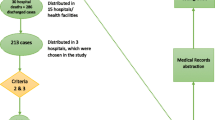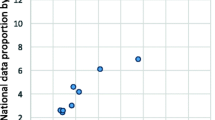Abstract
Validation of findings of verbal autopsy to assess the cause(s) of death during infancy was tested by comparing the information gathered by lay reporters with that generated by professionally trained personnel. This information was obtained on 280 infant deaths and 107 stillbirths reported from 40 villages in two community development blocks where a reliable information system has been established. During neonatal period, in 156 deaths, 222 underlying or associated causes were identified with 75.7% agreement. In the post neonatal period, 266 causes were recorded in 124 deaths with 83.1% agreement. In 97 of 107 stillbirths reported, agreement was found. Neonatal tetanus and measles (fever with rash) as cause of death matched fully; poor agreement was found in conditions like refusal of feeds; jaundice; septicemia and vomiting. There was full matching of agc at death between 8 days and 365 days and 86.7% agreement below 8 days. Lay reporters can be used for determining cause(s) of deaths during infancy by a recall of sequence of events preceding death and recording easily recognizable signs and symptoms. There is scope for training of lay reporters to obtain even greater correlation between their finding and those of professionals.
Similar content being viewed by others
References
Report of the working groupon health for all—An alternative strategy. Joint committee of ICMR and ICSSR, New Delhi, 1980
Kumar V, Dalta N. Intervention strategies for reduction of infant mortality.Indian J Pediatr 1985;52: 127–132
Health for all by the year 2000 AD. Report of the working group of India, Ministry of Health and Family Welfare, New Delhi, 1981
Registrar General of India,Survey on in/art and child mortality, 1979. Ministry of Home Affairs, New Delhi, 1983
Kumar V, Datta N. Community based studies on infant mortality in Haryana. Methodological issues relating to reporting and causation. Presented at theSeminar on the Determinants of infant mortality in India. Gujarat Institute of Area Planning and Population Council (New York), Ahmedabad, 1984
Kumar V, Datta N. Lay reporting and verbal autopsy in assessment of infant mortality.Indian J Pediatr 1986;53: 672–73
Holla M. Vital statistics system — A major source of information on infant and child mortality.Indian J Pediatr 1985;62:115–126
World Health Organisation.Case management of ARI in children in developing countries. Report of a working group meeting, WHO Geneva, 1984
Kumar V. Datta N. Birth weight as an indicator of health.Indian Pediatr 1984;21:113–118
Grant JP.The stau of world’s children. UNICEF, New York 1982-83
Mortality in infancy and childhood in India. A report to the USAID, New Delhi, Ed. Puffer RR, New Delhi, 1985
Kumar V, Datta N. Problems of rural neonates and possible solutions.Child life and Health 1984;4:5–9
World Health Organisation.International classification of disease. Ninth Revision, Geneva, 1977
Author information
Authors and Affiliations
Rights and permissions
About this article
Cite this article
Datta, N., Mand, M. & Kumar, V. Validation of causes of infant death in the community by verbal autopsy. Indian J Pediatr 55, 599–604 (1988). https://doi.org/10.1007/BF02868443
Issue Date:
DOI: https://doi.org/10.1007/BF02868443




